Episode #424: Why Your Math Goals Might Not Be Working — and What One Team Changed
LISTEN NOW HERE…
WATCH NOW…
Is your school or district chasing improvement—but feeling like nothing sticks? You’re not alone. Fragmentation and unclear goals might be the reason you’re not seeing real change.
In this episode, we go beyond theory and dive into a real-world case study of a school leadership team that thought they were aligned—until a simple conversation around “fluency routines” exposed deeper issues of misalignment. We explore how schools and systems can overcome the illusion of alignment by building true coherence—from a shared purpose to consistent support structures.
Listeners will:
- Identify signs of false alignment and fragmentation within their school or system
- Discover how to maintain autonomy at the school level while still supporting system-wide goals
- See how professional development, assessments, and resources must align with a common outcome
- Gain insight into how clarity at all levels—classroom, school, district—drives sustainable change
- Learn how to initiate deep conversations that surface misalignment and lead to shared understanding
Whether you’re a district leader, coach, or classroom teacher, this episode will help you identify misalignment in your system and take concrete steps toward coherence.
Attention District Math Leaders:
Not sure what matters most when designing math improvement plans? Take this assessment and get a free customized report: https://makemathmoments.com/grow/
Ready to design your math improvement plan with guidance, support and using structure? Learn how to follow our 4 stage process. https://growyourmathprogram.com
Looking to supplement your curriculum with problem based lessons and units? Make Math Moments Problem Based Lessons & Units
Be Our Next Podcast Guest!
Join as an Interview Guest or on a Mentoring Moment Call
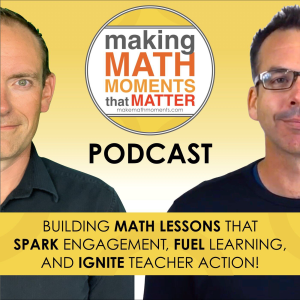
Apply to be a Featured Interview Guest
Book a Mentoring Moment Coaching Call
Are You an Official Math Moment Maker?
FULL TRANSCRIPT
Jon Orr: In this episode, we want to deepen the knowledge that we brought to the previous episode on establishing coherence and visions across school systems. In that episode, we unpacked some research, we referenced a few articles, some resources that we’ve been finding useful and sharing with our district improvement partners, our schools that we support on improvement processing, and we unpacked the idea that that fragmentation is often existing in our school system and we have to overcome that. We were working on too many things, we were focused on not enough priority on the right things and that fragmentation has caused our system to just have so much out here that it’s impossible for us to actually make sustainable improvement. So we talked about a recommendation to get more narrow, obviously to create a vision. of high quality instruction, but then understand the coherence of that vision because that coherence is what actually can create our improvement and understanding what we mean when we say one thing versus another. But we wanna continue this conversation with this case study that we started that episode with. Yvette, let’s dig in.
Yvette Lehman: Okay, so just a reminder to everybody, the call that had us questioning maybe some next steps or some changes for the future was that the school team that has four leads that are part of the school level math leadership team are striving toward improvement around mathematical fluency for students. They’ve identified a milestone that they want to hit by the end of this year, which is the implementation of what they’re describing as fluency routines three times a week in all classrooms. But when we started to ask, you know, what do you mean by fluency? What is a fluency routine? How would you describe it? If I was to walk into your classroom six months from now, what should I see, hear, feel during these fluency routines? And the four leaders at the table all had very drastically different interpretations of what they meant by fluency. Are they talking fact fluency, conceptual fluency, procedural fluency? What do they define fluency as? But then also even what should we see happening in classrooms was drastically different. Like some were talking about time tests on Friday, every Friday, and posting students’ results because students are competitive and so they want to see how fast they were at solving these problems. One was talking about working through the facts systematically and, you know, checking off when students have their zeros, have their ones, have their twos, have their three. One teacher was talking about what they do in small group around fluency and how students are steering their… It was just, there was a varied response to that question that led me to believe that perhaps, although there was a vision on the paper There was an objective identified. There was a milestone that to me was realistic and made sense that it wasn’t really clear what outcome they were hoping for.
Kyle Pearce: Right. I think it’s really easy and it’s not shocking to me. know, like this isn’t the first time that we’ve had this experience, right? When you got off that call, it wasn’t the first time that we ran into a scenario where, you know, the actual understanding or the meaning behind some of the words we were using varied across different groups. We’ve experienced it in our own experience at our district, our former district. and we see it quite often. And I think this is one of the biggest challenges that we experience, not just in education, but other aspects of life. You know, when we’re in conversation and we say certain things, we assume other people have the exact same definition. And it is very, very nuanced, especially in, the math classroom to get very clear on that. So I guess the question then becomes is like what, you know, what are the next steps and like, what are we hashing out here in order to help this group so that they can become more less fragmented and more clear on what it means so that we can, instead of going from, I’m gonna call it like a 30,000 foot view of like what fluency might be to more of like ground level. Like how do we get to ground level to say like, if we are seeing a change in fluency, we can actually notice and name some of the different things we’re seeing so that we can identify them and we can feel good about them. Or if we’re not seeing those things, that we can make some tweaks along the way in order to try to start seeing some of those results that we’re actually after.
Jon Orr: Yeah, and I wanna get into those next steps specifically, but I think what we all battle in education specifically in the leadership level is this curse of knowledge, right? Like we know what we know and we assume other people know when we say it. Because I think that’s what you’re saying, Kyle, is that we make this assumption that when I say fluency, you understand what I mean, but that’s not the case. You’ve got a completely different image in your mind of what that looks like, and this is what this team is battling, right? But they made the assumption. And everyone at the team made the assumption, like, yeah, we’re talking fluency. I’ve made the assumption that the word means the same or the term or the actions, the processes, the practice means the same everywhere. So even if I said like, I’m building resiliency in math class, like everyone in your group is also gonna have a different version of what that means to them. And it doesn’t look the same in one class versus the other. You know it doesn’t look the same. That’s why it’s. being different, like that’s why that teacher’s teaching the way that it is, because they think they’re doing it when you start to say it. So when you’re, so even take this little step further Yvette, is like thinking about like, when I’m delivering professional development across the system, and I don’t make that, and I’m making that assumption that I’m talking about like, we’re doing this because we’re trying to build resiliency, or this is the reason we do this to build resiliency, but the teacher’s like, I do that. I build resiliency every day. I show kids how to solve problems by walking them step by step through this process. Like, I’m showing them how to be resilient, but am I? Right, like, our definitions of resilience here are different, but we just make the assumption. So what actually happens at PD sessions, or when teachers are hearing it, when they hear the word, they tune out sometimes, they’re like, I’m good at that already.
Kyle Pearce: You want a word that came to mind, John, when you talked about resilience, the word that is so miss aligned on is rigor. When we say rigor, we say it in education all the time. What is being rigorous mean? I know what it means in a lot of classrooms. It means torturing children with a lot of things to do, but not necessarily making it what I would deem as being rigorous, right? So it’s like these are so common. And there’s so many terms that have such a depth of what possibly, you know, the meaning could be that, you know, I think as we do some of this work and we unpack what we’re after, some of the work we do around monitoring can also be really helpful because when we actually go to monitor, we have to identify like what changes do we want to see? And in some ways that might bring you all the way back to the beginning and you might recognize that maybe you’re not. all 100 % clear and coherent on some of those things. Like when I’m looking for a certain thing to take place in my classroom, but that’s not what you’re looking for. I’ve now identified that, shoot, we thought we were coherent, but maybe we’re not.
Yvette Lehman: I’m gonna share the recommendations, the immediate next steps that I shared with this team. But I think that more importantly, What it made me question was the system that this team is a part of. And so my recommendations specifically for the team were, I think it would be great if as a team, we could have a more common definition of what we mean when we say we want to increase student fluency and we want to support the implementation of fluency routines. So my recommendation to them was do a book study around figuring out fluency from Jennifer Bay Williams and John San Giovanni so that as a core team, you can land on some a more common definition of the outcome that you’re trying to achieve. And I said even, you know, the summit’s coming up, Jennifer Bay Williams is going to be a speaker at the summer. I know she’s specifically talking about interventions for students who are struggling with fluency. There’s sometimes a too much choice when it comes to conferences, but maybe that’s the one session you agree to attend or you watch the replay during an upcoming leadership team meeting. So, you know, let’s try to as a team, get more an alignment around what it is we’re hoping the outcome is. What do we want for students long-term, but also what change do we want to see in our classrooms in the short-term? But that to me was the smaller dilemma. To me, the bigger dilemma was this is a school that’s part of a system. And how is the system creating this fragmentation possibly without, not intentionally, but how could we maybe enhance the system to lead to more coherence. And so this is what I wondered. In this particular system, there’s a lot of autonomy at the school level as far as the direction or the outcome they’re hoping for, which is great. We want autonomy, but because there is maybe they’re too high on the autonomy end, perhaps there are missed opportunities for this system to work together to really work toward an outcome of increasing student fluency collectively. And so I’m going to share with you an example of a system that is working toward this. So imagine that at the state level, the national level, the provincial level, you decide that you are committed to increasing student fluency, that that’s an outcome that you want for all learners. That’s the state level then. you know, has to provide assessments that reflect that. So if you have state level assessments of math achievement, you need to select an assessment that’s going to truly measure fluency, which means that you need to understand what you mean by fluency. And you need to be able to clearly communicate that to the other levels of this system. So from the state level all the way down to the classroom, The assessment that we use to determine change or to measure impact on student achievement around fluency should reflect our common understanding of what we mean by fluency. The instructional materials that we offer educators, as far as, you know, here’s a list of approved resources, either at the district level or the state level or the provincial level, should include high quality materials that support strong research-based fluency routines because we all have a common understanding of what we mean by fluency. And so I think sometimes when we have these really autonomous school level goals that are not part of a coherent system where the assessment, the instructional materials, the professional development all reflect this shared understanding of the outcome we want for students as far as our definition, a true definition of what we mean by fluency. Do we have a common understanding? Like are we leaning towards the Jennifer Bay Williams, Johnson Giovanni interpretation of fluency as efficiency, accuracy, flexibility? Are we looking for automaticity of basic facts? Are we looking for memorization? Are we looking for a variety of strategies when students are demonstrating computational fluency? Are we looking for the standard algorithm? These are drastically different approaches. And if in one classroom we’re defining fluency as memorization and proficient with the standard algorithm, and another classroom we’re defining fluency as automaticity of basic facts and flexibility of strategy, we no longer have a coherent system. And we’re likely going to be very fragmented. We’re not going to see sustainable change over time if we’re not at all three levels working toward the same moral outcome, which is of course we want our students to be able to flexibly, accurately, and efficiently work with all four operators for the purpose of problem solving.
Kyle Pearce: Hmm. You know, you mentioned what popped into my mind is the idea around oftentimes in systems and districts where there’s many schools, they want to give that autonomy out, which is important to have some autonomy, but without enough clarity as to what you can do with that autonomy. So for example, you’re doing a school-based plan. And sometimes you it almost feels as though some of the schools are trying to be as creative as possible in terms of like what their school improvement plan looks and sounds like instead of going, no, we’re going to do these specific things to help us get closer to that common goal of fluency. And we’re going to do it through these things. And if we were to look at all the different school based plans, they should all like you should almost be able to interchange. Like if you were to take one idea and put it in a different building, we should be able to. flip-flop these ideas around and they should all still be helping you get towards that more common goal instead of something that’s a lot more broad and a lot more vague. So in my mind, I wonder as well, when we get clear, it doesn’t necessarily remove autonomy, but rather it allows your autonomy to be more focused, but still differentiated enough so that you can do it within your means in your own context.
Jon Orr: Right, like you’re saying the what is defined, but the how isn’t. So we can, we can leave it to the school sites to figure out how, but we’re all working towards this. Let’s, if we’re all working towards that and you’ve got a great idea because we, but also we have this shared understanding because we’ve done work there to make sure that we have a shared coherent understanding of what that looks like, sounds like, feels like, then, hey, it’s a perfect condition for now you to figure out the how. to get there. Think about that at the school level, even at this school level. It’s like if we had a shared understanding across that, then you no doubt trust so many teachers to start moving towards the right things to choose for their classrooms if they’re making choices. Because you want teachers to have autonomy. But you’re like, completely trust it because I know that you and I have the same definition of fluency. So you’re going to make appropriate choices to get there. So it trickles like it’s fractal at the school level to the, you know, to the, to the district level, because you who are leading that work understand and have assessed in a way the people you’re supporting that we have this common understanding, this coherence, because when you have it, you’re like, go forth, you know, it’s almost like as a parent, you’re like, I have, I don’t, I don’t trust my kid to like walk, you know, be out after dark, what happens if they make this decision or this decision or this decision? It’s probably because you just don’t, you don’t have enough evidence that supports yet that they have made good decisions and they have the same understanding about values as yourself. When you’re like, I know they have the same values that I’m having, or I know that those values mean this, being this, you completely trust your child to go out and like live life because they’re going to make good choices. This is what we want at any fractal level of a system.
Yvette Lehman: So our recommendation, I guess today, is not very different from what we shared on the Monday episode this week, which is essentially at the end of the day, whether you’re, you know, you only can control the school level. So you’re a teacher right now listening to this episode and you’re like, well, I can’t control what the district is doing. I can’t control what the province or state is doing within your own system. Do you have a common understanding of the student outcome that you’re striving for? then zoom out. If you’re a superintendent listening, if you are a district coordinator listening, does your system have a common understanding of the outcome that you’re striving for and are you working as a system? At the district level, are you doing what is necessary to ensure that teachers have what they need, get the learning that is required, the resources aligned? That’s where we get disconnected is when we say that we value one thing, but then we have a district-wide assessment that values something else. Like that fragmentation is going to be a, it’s a wrong driver, right? It’s something that’s going to actually prevent change rather than support it. So at whatever level you are, you know, supporting right now, how are you contributing to the systemness? How are you ensuring that others see themselves in this change and that you’re supporting. engaging in deep learning together for a moral purpose and then the one that we’re describing now is like of course we want all students to have the skills, have the understanding, have the confidence to engage flexibly with all four operators of course. What are we going to do to ensure that?
Kyle Pearce: And how I’m gonna interpret that as like something that could be actionable regardless of the position you’re in. So you are working with four leaders who are working towards clarifying their district vision. But when they become clear on those four, I want you, if you’re a teacher, you might have three colleagues that are working in your grade band that you can become clear together on. So. whoever’s in your direct network, you can gain that clarity at your level. And then the goal there is that say it’s four people, you and three other people. And now whoever they’re sort of impacting or they’re connected to, this is the fractal idea John’s talking about. If we get clear as a group of four, and then I go off and I’m working with my students or I’m working with different groups of students or I’m working with different colleagues, I can help them to also become clear. just like the other three that were a part of our group. And as we do that, that compounding effect does happen. Now, at the district level, we’ve got a big job to build that coherence. But within the system, we need everybody being a part of that work, which also means gaining your own understanding and getting clear on what these ideas mean. And then here’s the other piece is it’s okay to ask questions when you’re not clear, right? Asking questions is how we can highlight that maybe there is a lack of clarity across a group or a subsystem of the actual district.
Jon Orr: We do this, this is the work that we do. So if you’re saying like this all makes sense but I’m not sure exactly how, then reach out to us. MakeMathMoments.com for us. Discovery, on a call with us. We guide teams, support teams, give them resources, feedback, ideas, suggestions, consultation to create this type of operating system inside their school system at whatever level that happens to be. So reach out to us again at MakeMathMoments.com forward slash. discovery and we can talk about what that support looks like to you so that you can create this in your system.
Thanks For Listening
- Book a Math Mentoring Moment
- Apply to be a Featured Interview Guest
- Leave a note in the comment section below.
- Share this show on Twitter, or Facebook.
To help out the show:
- Leave an honest review on iTunes. Your ratings and reviews really help and we read each one.
- Subscribe on iTunes, Google Play, and Spotify.
DOWNLOAD THE 3 ACT MATH TASK TIP SHEET SO THEY RUN WITHOUT A HITCH!
Download the 2-page printable 3 Act Math Tip Sheet to ensure that you have the best start to your journey using 3 Act math Tasks to spark curiosity and fuel sense making in your math classroom!
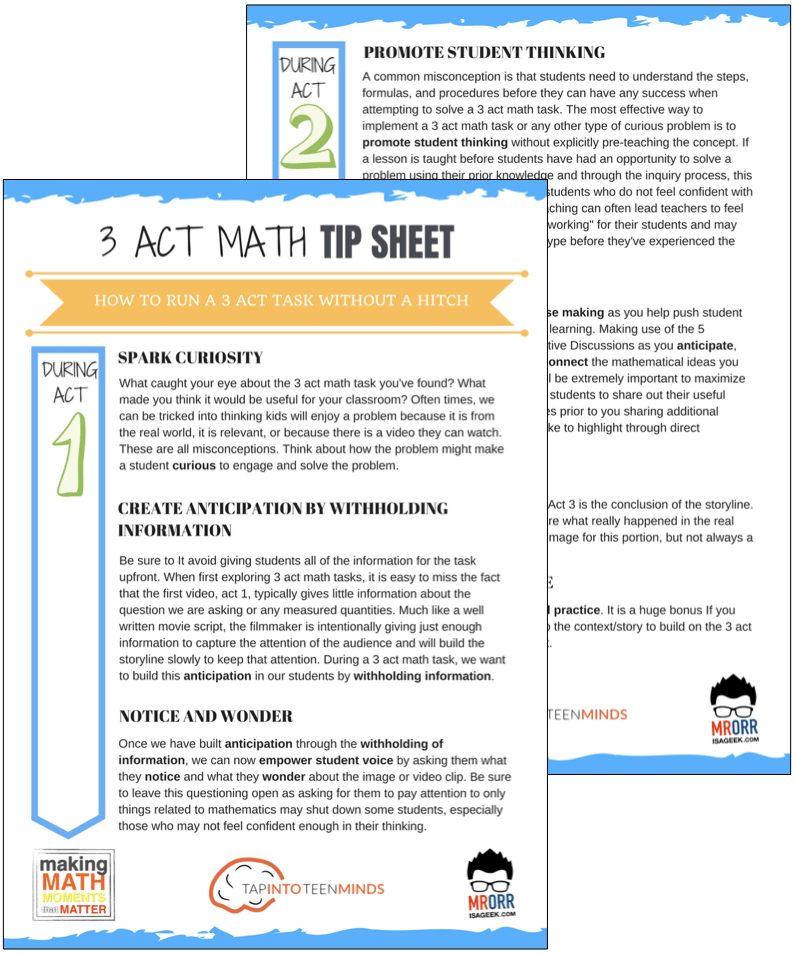
LESSONS TO MAKE MATH MOMENTS
Each lesson consists of:
Each Make Math Moments Problem Based Lesson consists of a Teacher Guide to lead you step-by-step through the planning process to ensure your lesson runs without a hitch!
Each Teacher Guide consists of:
- Intentionality of the lesson;
- A step-by-step walk through of each phase of the lesson;
- Visuals, animations, and videos unpacking big ideas, strategies, and models we intend to emerge during the lesson;
- Sample student approaches to assist in anticipating what your students might do;
- Resources and downloads including Keynote, Powerpoint, Media Files, and Teacher Guide printable PDF; and,
- Much more!
Each Make Math Moments Problem Based Lesson begins with a story, visual, video, or other method to Spark Curiosity through context.
Students will often Notice and Wonder before making an estimate to draw them in and invest in the problem.
After student voice has been heard and acknowledged, we will set students off on a Productive Struggle via a prompt related to the Spark context.
These prompts are given each lesson with the following conditions:
- No calculators are to be used; and,
- Students are to focus on how they can convince their math community that their solution is valid.
Students are left to engage in a productive struggle as the facilitator circulates to observe and engage in conversation as a means of assessing formatively.
The facilitator is instructed through the Teacher Guide on what specific strategies and models could be used to make connections and consolidate the learning from the lesson.
Often times, animations and walk through videos are provided in the Teacher Guide to assist with planning and delivering the consolidation.
A review image, video, or animation is provided as a conclusion to the task from the lesson.
While this might feel like a natural ending to the context students have been exploring, it is just the beginning as we look to leverage this context via extensions and additional lessons to dig deeper.
At the end of each lesson, consolidation prompts and/or extensions are crafted for students to purposefully practice and demonstrate their current understanding.
Facilitators are encouraged to collect these consolidation prompts as a means to engage in the assessment process and inform next moves for instruction.
In multi-day units of study, Math Talks are crafted to help build on the thinking from the previous day and build towards the next step in the developmental progression of the concept(s) we are exploring.
Each Math Talk is constructed as a string of related problems that build with intentionality to emerge specific big ideas, strategies, and mathematical models.
Make Math Moments Problem Based Lessons and Day 1 Teacher Guides are openly available for you to leverage and use with your students without becoming a Make Math Moments Academy Member.
Use our OPEN ACCESS multi-day problem based units!
Make Math Moments Problem Based Lessons and Day 1 Teacher Guides are openly available for you to leverage and use with your students without becoming a Make Math Moments Academy Member.
Partitive Division Resulting in a Fraction
Equivalence and Algebraic Substitution
Represent Categorical Data & Explore Mean
Downloadable resources including blackline masters, handouts, printable Tips Sheets, slide shows, and media files do require a Make Math Moments Academy Membership.
ONLINE WORKSHOP REGISTRATION
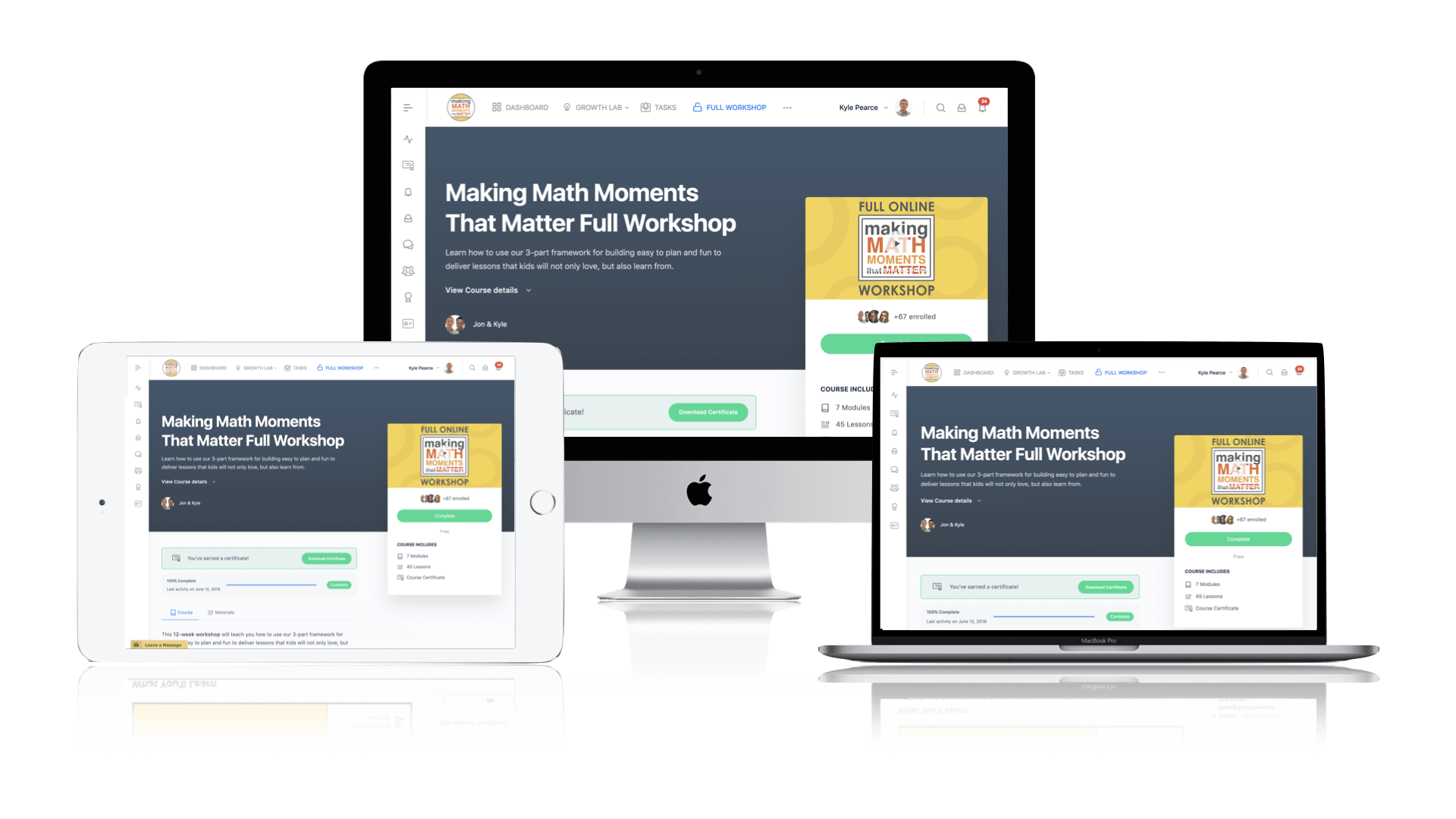
Pedagogically aligned for teachers of K through Grade 12 with content specific examples from Grades 3 through Grade 10.
In our self-paced, 12-week Online Workshop, you'll learn how to craft new and transform your current lessons to Spark Curiosity, Fuel Sense Making, and Ignite Your Teacher Moves to promote resilient problem solvers.
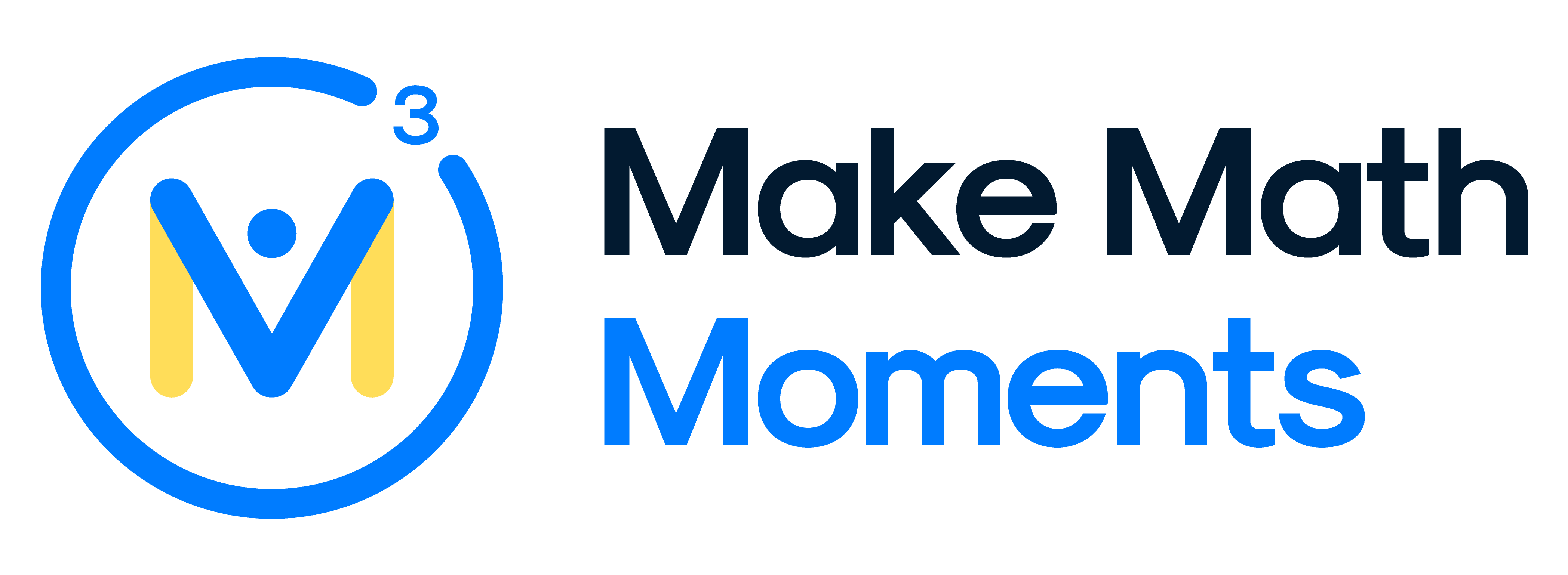



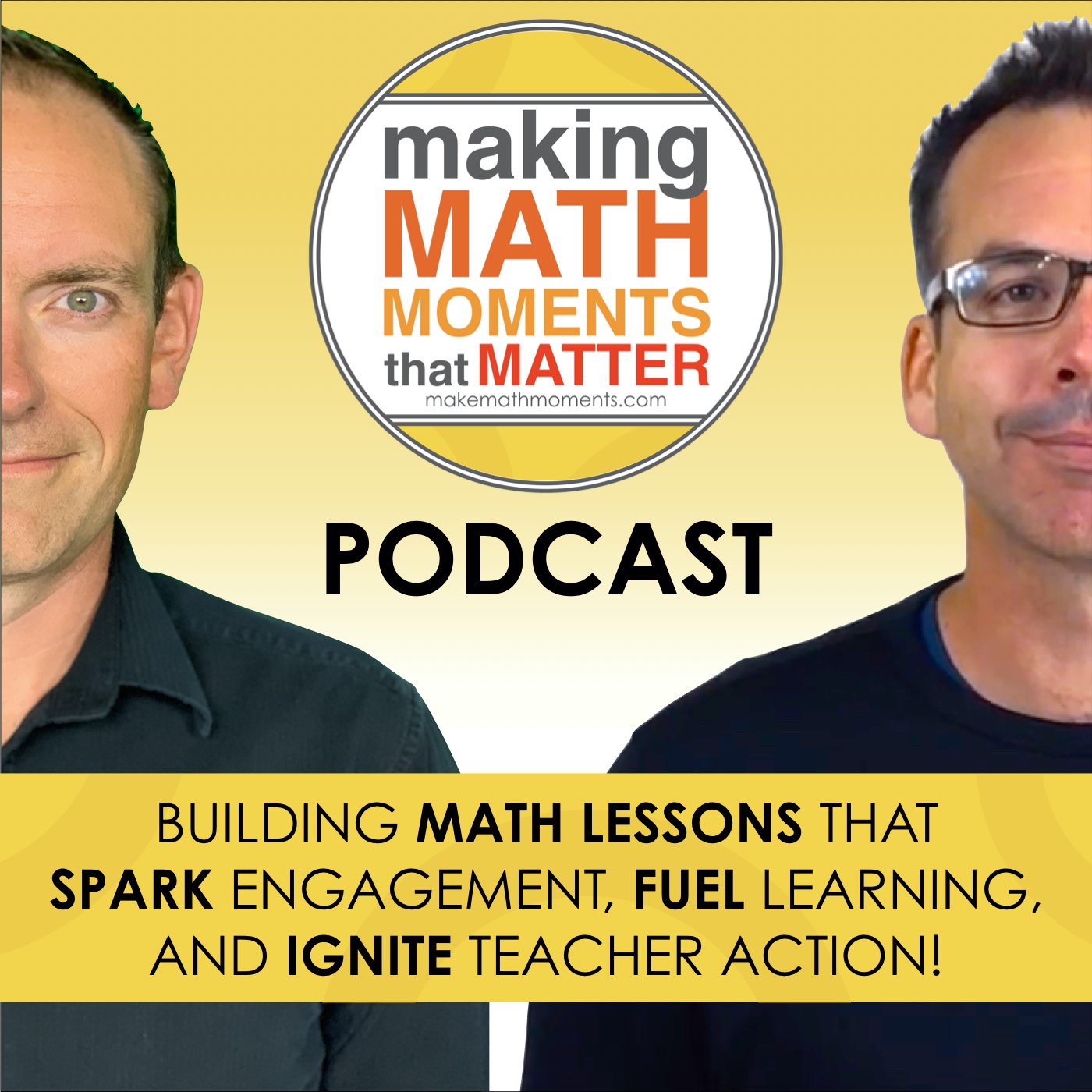

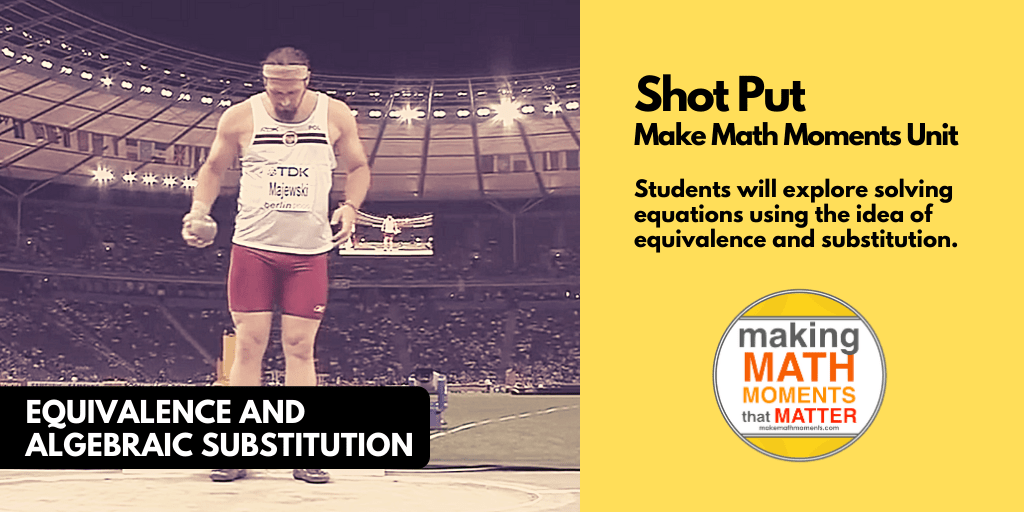
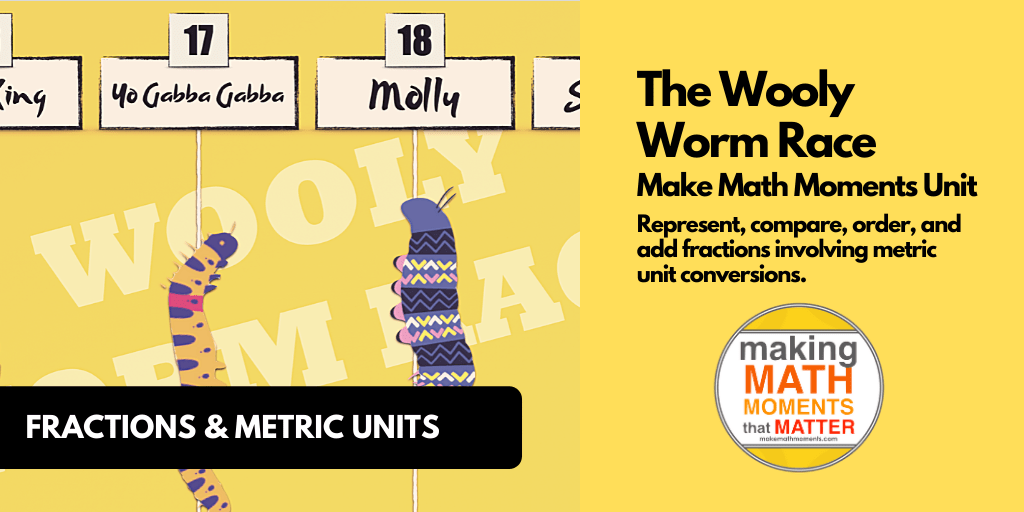
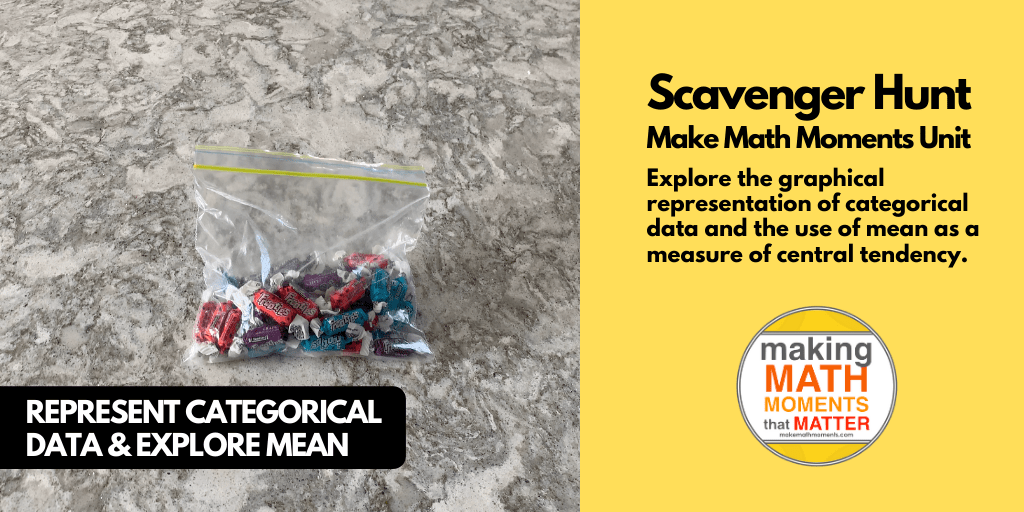
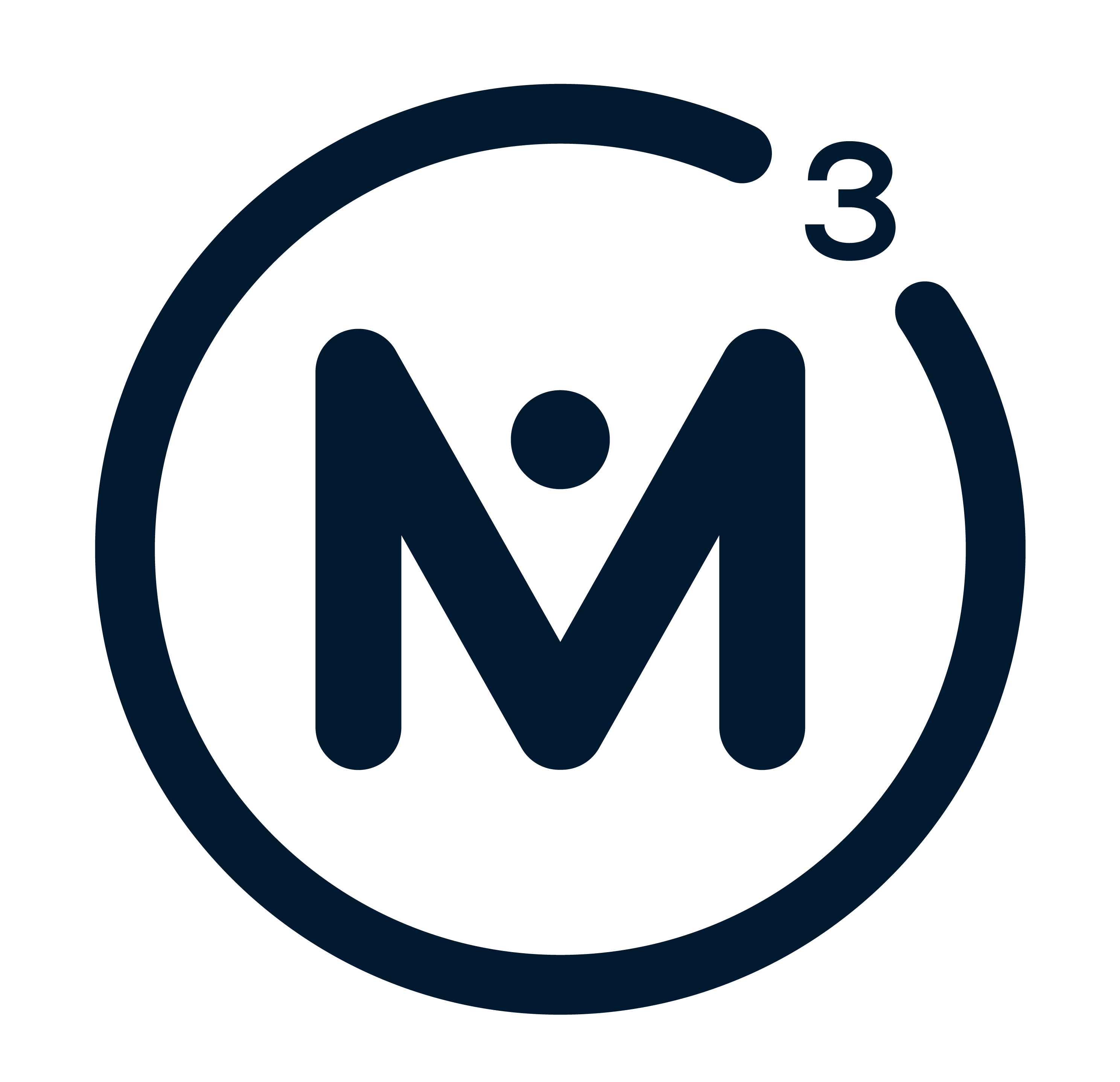
0 Comments